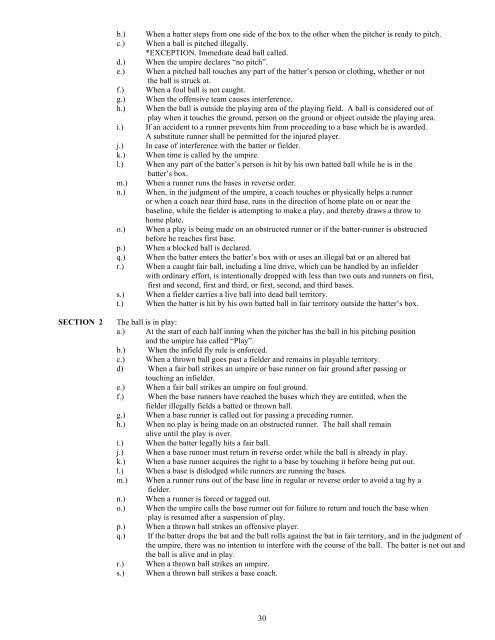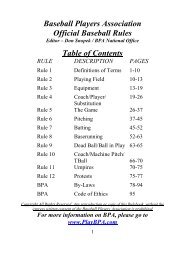baseball players association rule 1 definitions of terms
baseball players association rule 1 definitions of terms
baseball players association rule 1 definitions of terms
You also want an ePaper? Increase the reach of your titles
YUMPU automatically turns print PDFs into web optimized ePapers that Google loves.
.)<br />
c.)<br />
d.)<br />
e.)<br />
f.)<br />
g.)<br />
h.)<br />
i.)<br />
j.)<br />
k.)<br />
l.)<br />
m.)<br />
n.)<br />
o.)<br />
p.)<br />
q.)<br />
r.)<br />
s.)<br />
t.)<br />
When a batter steps from one side <strong>of</strong> the box to the other when the pitcher is ready to pitch.<br />
When a ball is pitched illegally.<br />
*EXCEPTION. Immediate dead ball called.<br />
When the umpire declares “no pitch”.<br />
When a pitched ball touches any part <strong>of</strong> the batter’s person or clothing, whether or not<br />
the ball is struck at.<br />
When a foul ball is not caught.<br />
When the <strong>of</strong>fensive team causes interference.<br />
When the ball is outside the playing area <strong>of</strong> the playing field. A ball is considered out <strong>of</strong><br />
play when it touches the ground, person on the ground or object outside the playing area.<br />
If an accident to a runner prevents him from proceeding to a base which he is awarded.<br />
A substitute runner shall be permitted for the injured player.<br />
In case <strong>of</strong> interference with the batter or fielder.<br />
When time is called by the umpire.<br />
When any part <strong>of</strong> the batter’s person is hit by his own batted ball while he is in the<br />
batter’s box.<br />
When a runner runs the bases in reverse order.<br />
When, in the judgment <strong>of</strong> the umpire, a coach touches or physically helps a runner<br />
or when a coach near third base, runs in the direction <strong>of</strong> home plate on or near the<br />
baseline, while the fielder is attempting to make a play, and thereby draws a throw to<br />
home plate.<br />
When a play is being made on an obstructed runner or if the batter-runner is obstructed<br />
before he reaches first base.<br />
When a blocked ball is declared.<br />
When the batter enters the batter’s box with or uses an illegal bat or an altered bat<br />
When a caught fair ball, including a line drive, which can be handled by an infielder<br />
with ordinary effort, is intentionally dropped with less than two outs and runners on first,<br />
first and second, first and third, or first, second, and third bases.<br />
When a fielder carries a live ball into dead ball territory.<br />
When the batter is hit by his own batted ball in fair territory outside the batter’s box.<br />
SECTION 2<br />
The ball is in play:<br />
a.) At the start <strong>of</strong> each half inning when the pitcher has the ball in his pitching position<br />
and the umpire has called “Play”.<br />
b.) When the infield fly <strong>rule</strong> is enforced.<br />
c.) When a thrown ball goes past a fielder and remains in playable territory.<br />
d) When a fair ball strikes an umpire or base runner on fair ground after passing or<br />
touching an infielder.<br />
e.) When a fair ball strikes an umpire on foul ground.<br />
f.) When the base runners have reached the bases which they are entitled, when the<br />
fielder illegally fields a batted or thrown ball.<br />
g.) When a base runner is called out for passing a preceding runner.<br />
h.) When no play is being made on an obstructed runner. The ball shall remain<br />
alive until the play is over.<br />
i.) When the batter legally hits a fair ball.<br />
j.) When a base runner must return in reverse order while the ball is already in play.<br />
k.) When a base runner acquires the right to a base by touching it before being put out.<br />
l.) When a base is dislodged while runners are running the bases.<br />
m.) When a runner runs out <strong>of</strong> the base line in regular or reverse order to avoid a tag by a<br />
fielder.<br />
n.) When a runner is forced or tagged out.<br />
o.) When the umpire calls the base runner out for failure to return and touch the base when<br />
play is resumed after a suspension <strong>of</strong> play.<br />
p.) When a thrown ball strikes an <strong>of</strong>fensive player.<br />
q.) If the batter drops the bat and the ball rolls against the bat in fair territory, and in the judgment <strong>of</strong><br />
the umpire, there was no intention to interfere with the course <strong>of</strong> the ball. The batter is not out and<br />
the ball is alive and in play.<br />
r.) When a thrown ball strikes an umpire.<br />
s.) When a thrown ball strikes a base coach.<br />
30



